|
|
|
[PANICULATE GRASSES]
|
|
|
|
|
80a
|
(21) |
Inflorescence more or less contracted: shape spike-like (very short branches), or cylindrical (short, even branches), or a spindle or very narrowly ovoid (oblong), OR shape difficult to ascribe to a simple geometric form (for example, spikelets clustered forming lobes on branches mostly in one plane; infloresence shape crudely triangular) .. .
|
|
[81] |
|
80b
|
|
Inflorescence open, overall shape tending to ovoid (see Figs. 14A and 14B, above) or some other broadly rounded shape, not appearing spike-like .. .
|
|
[82]
|
|
~~~~ ~~~~~~~~~~~~~~~~~~~~~~~~~
|
|
|
81a
|
(80) |
Inflorescence roughly cylindrical, narrowing somewhat at the top end, the branches and spikelets crowded around a central axis and, if branched, the branches appressed (held upright and close) to the central axis giving the general appearance of a spike; OR shape tending to ovoid, branches off culm not appressed but decreasing evenly in length up the culm .. .
|
|
[88] |
|
81b
|
|
Inflorescence shape other than cylindrical: somewhat open and oblong, pyramidal, broom- or fan-like, or difficult to ascribe to a geometric shape .. .
|
|
[100]
|
|
~~~~ ~~~~~~~~~~~~~~~~~~~~~~~~~
|
|
|
82a
|
(80) |
Inflorescence silky and/or plumose due to spikelets having an abundance of thin, usually white, bristles .. .
|
|
[89] |
|
82b
|
|
Inflorescence not silky; spikelets without silky bristles .. .
|
|
[83]
|
|
~~~~ ~~~~~~~~~~~~~~~~~~~~~~~~~
|
|
|
83a
|
(82) |
Most spikelets with one or more conspicuous awns extending well beyond the spikelet .. .
|
|
[101] |
|
83b
|
|
Spikelets without conspicuous awns; if awns present, these are short, shorter than or about as long as bractlet (glume or lemma) to which they are attached .. .
|
|
[84]
|
|
~~~~ ~~~~~~~~~~~~~~~~~~~~~~~~~
|
|
|
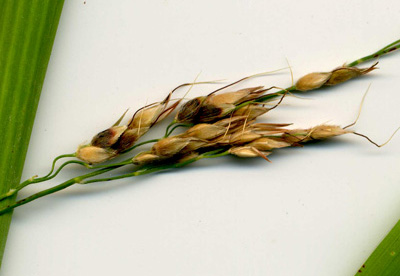
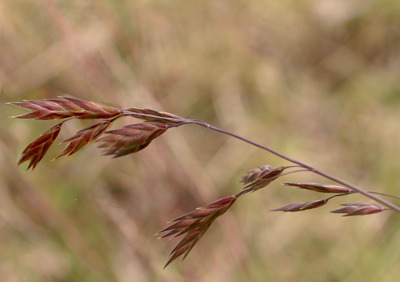
|
|
Figures 14C and 14D. Floret counts: (left) panicle of 2-flowered spikelets (Sorghum
halepense) in which lemma of second floret is awned; (right) a panicle of spikelets
with multiple florets (Bromus catharticus).
|
|
|
[NOTE: THREE CHOICES HERE]
|
|
84a
|
(83) |
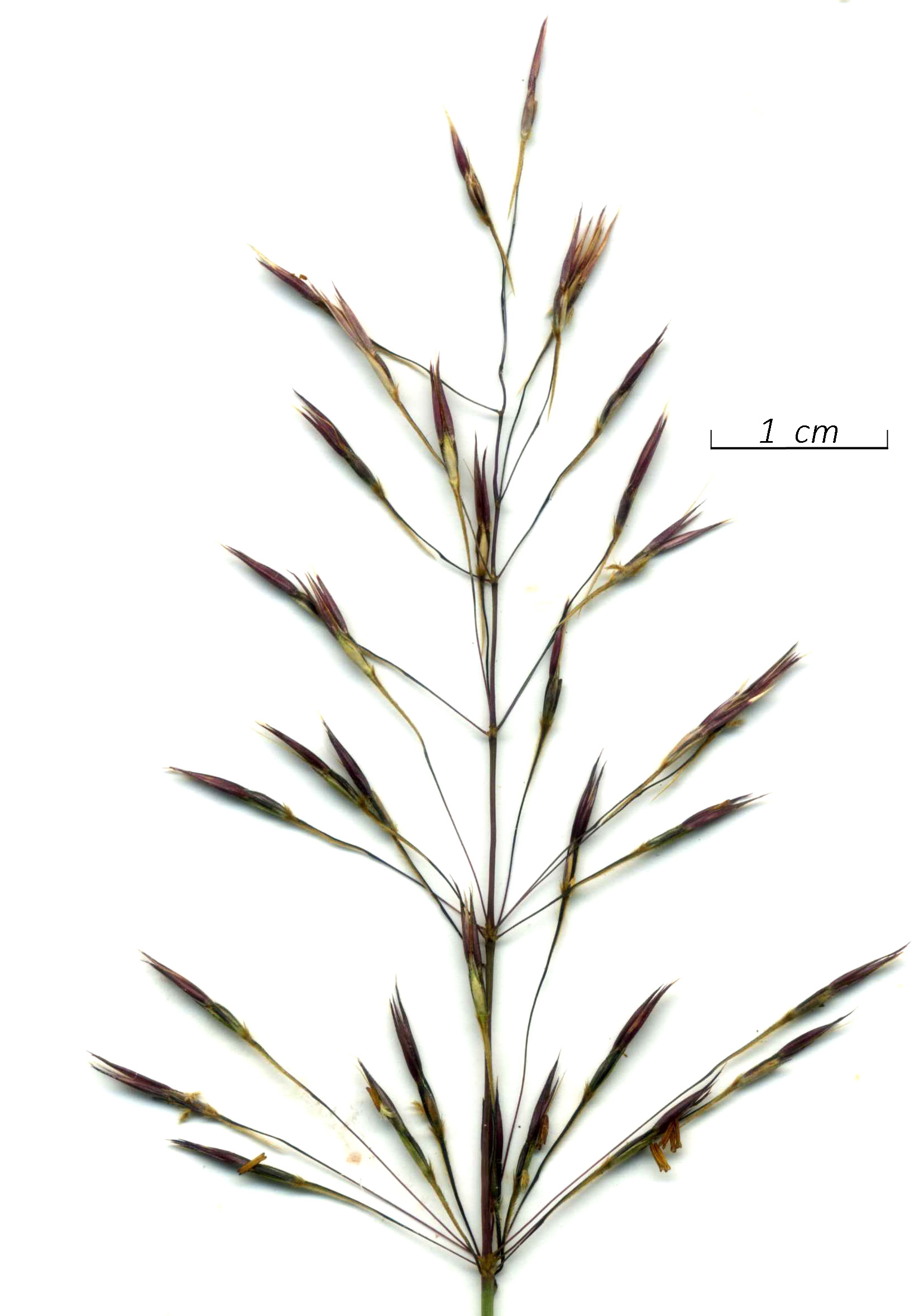 Inflorescence elliptical or short cylindrical, primary branches arising whorled at nodes and spreading upwards, each branch with three (sometime two) spikelets clustered at end: one sessile the other(s) on pedicel(s). Spikelets with no or short awn, about as long as supporting glume. Ligule a membrane or a dense line of very short hairs. { Small, spreading grass, on dry, exposed ground, but also appearing as or in a lawn; common on Guam. USDA noxious weed. Manienie ‘ula, golden beardgrass [HAW - IND?] inifuk, palaii [GUM - IND]
Inflorescence elliptical or short cylindrical, primary branches arising whorled at nodes and spreading upwards, each branch with three (sometime two) spikelets clustered at end: one sessile the other(s) on pedicel(s). Spikelets with no or short awn, about as long as supporting glume. Ligule a membrane or a dense line of very short hairs. { Small, spreading grass, on dry, exposed ground, but also appearing as or in a lawn; common on Guam. USDA noxious weed. Manienie ‘ula, golden beardgrass [HAW - IND?] inifuk, palaii [GUM - IND]Chrysopogon aciculatus (Retz.) Trin.
Figures 14E. Inflorescence of Chrysopogon aciculatus showing tight
clusters of three spikelets at the ends of each branch off the culm.
|
|
84b
|
|
Inflorescence shape variable; spikelets not arranged in close groupings and each Spikelet of one or two florets, but no more than three (see Fig. 14C, left above) .. .
|
|
[85] |
|
84c
|
|
Inflorescence shape variable; spikelets not arranged in close groups but each spikelet with multiple florets (more than two; as in Fig. 14D, right above). Ligule membranous .. .
| |
[89] |
|
~~~~ ~~~~~~~~~~~~~~~~~~~~~~~~~
|
|
|
85a
|
(84) |
Spikelets about 2.8 mm (1/10 in) long, single at the tips of long, three-sided, scabrous branches; spikelets spindle-shaped, not or hardly compressed. Glumes unequal, the lower glume clasping and much shorter than spikelet .. .
|
|
[94] |
|
85b
|
|
Spikelets somewhat compressed, oblong in outline, upper or both glumes exceed lemmas .. .
|
|
[87] |
|
~~~~ ~~~~~~~~~~~~~~~~~~~~~~~~~
|
|
|
87a
|
(85) |
 Inflorescence open, or closing after anthesis; spikelets crowded and tight against the rachis, each set on a conspicuous, cylindrical callus (base attached to rachilla). Spikelets compressed, covered by short hairs. Glumes together enclosing floret. Ligule may be very long (5 to 8 mm). { Perennial, small to moderate in size, spreading by stolons; culms typically decumbant (laying out flat). Found in disturbed, usually wet, sites. Creeping bent grass, marsh bent [HAW - NAT]
Inflorescence open, or closing after anthesis; spikelets crowded and tight against the rachis, each set on a conspicuous, cylindrical callus (base attached to rachilla). Spikelets compressed, covered by short hairs. Glumes together enclosing floret. Ligule may be very long (5 to 8 mm). { Perennial, small to moderate in size, spreading by stolons; culms typically decumbant (laying out flat). Found in disturbed, usually wet, sites. Creeping bent grass, marsh bent [HAW - NAT]
|
|
|
87b
|
|
Inflorescence open. Spikelets not or only slightly compressed, generally round in cross-section, without hairs (glabrous) or, if grass of moderate (not large) size, covered with fine hairs. First glume short but conspicuous, surrounding the base of the spikelet .. .
|
|
[94] |
|
~~~~ ~~~~~~~~~~~~~~~~~~~~~~~~~
|
|
|
88a
|
(81) |
Spikelet with only 1 or 2 florets .. .
|
|
[96] |
|
88b
|
|
Spikelet of multiple florets (more than two; see Fig. 14D above) .. .
|
|
[89] |
|
|
~~~~ ~~~~~~~~~~~~~~~~~~~~~~~~~
|
|
|
89a
|
(84) & (88) |
Spikelets with fewer than 10 florets, these imbricate or loosely so (overlapping, but rachilla visible in some spikelets); weakly or strongly compressed laterally. Florets with very short or no awns .. .
|
|
[90] |
|
89b
|
|
Spiklelets typically with more than 6 florets and up to 40 in some species; spikelets with florets usually tightly imbricate and compressed laterally, without awns or if present, awns very short .. .
|
|
[92] |
|
~~~~ ~~~~~~~~~~~~~~~~~~~~~~~~~
|
|
|
90a
|
(89) |
 Lemmas (bracts of each floret above the glumes) folded, keeled on the back, without awns. Leaf blades narrow or not. Inflorescence branches short or long, ascending or first branch of some clusters held straight out.. .
Lemmas (bracts of each floret above the glumes) folded, keeled on the back, without awns. Leaf blades narrow or not. Inflorescence branches short or long, ascending or first branch of some clusters held straight out.. .
|
|
[91] |
|
90b
|
|
Lemmas not keeled; rounded on the back, with short awns, these 1 to 5 mm continuations of the acute tips. Leaf blades narrow, with setae. Inflorescence branches short, ascending, spikelets reddish or purple tinged, { Found in pastures and shrubland above 2,500 ft on Maui and Hawai‘i islands. Red fescue [HAW - Nat]
|
|
|
|
~~~~ ~~~~~~~~~~~~~~~~~~~~~~~~~
|
|
|
91a
|
(90) |
Leaves coarse, margins parallel. Ligule a short, ciliate membrane. Paniculate inflorescence dense, somewhat spike-like. Spikelets (2)3-12(-14) flowered, greenish when fresh. Glumes subequal, shorter than first lemma, some with a short arista (narrow scabrous extension at tip). Lemma with 3 nerves. { Dense tufted perennial, 2-3 ft in height. Typically found on wind-blown sites, dry ridges, exposed dunes (see also couplet [101]). Kāwelu [HAW - END]Eragrostis variabilis (Gaud.) Steud.
|
|
|
91b
|
|
Leaf margins boat-shaped. Ligule a membrane, may be erose but not ciliate. Paniculate inflorescence open, pyramidal in shape. Glumes shorter than first lemma, acute tipped, but not aristate; lemma 5-nerved. Perennial or annual, tufted or spreading. Spikelets (2)3-6 flowered, purplish. Poa spp. .. .
|
|
[98] |
|
~~~~ ~~~~~~~~~~~~~~~~~~~~~~~~~
|
|
|
92a
|
(89) |
Lemmas of florets longer than wide .. .
|
|
[93] |
|
92b
|
|
Lemmas of florets unusually broad, as long as wide. Found above 1000-ft elevation. Briza spp. .. .
|
|
[97] |
|
~~~~ ~~~~~~~~~~~~~~~~~~~~~~~~~
|
|
|
93a
|
(92) |
Inflorescence shape overall tending to ovoid or columnar, or even spike-like. Spikelets with more than 10 florets or if florets fewer than 10, then spikelets tiny, about 1/16 in (2 mm) across (see Figure 14F); Spikelets compressed laterally. Glumes, if present, under 1 cm in length, Eragrostis spp. .. .
|
|
[90] |
|
93b
|
|
Florets 6-12 per spikelet, spikelets >1/4 in or 5 mm across, strongly compressed laterally, the lemmas sharp tipped or short-awned, keeled along the back (see Figure 14G); Glumes similar, about 1 cm (3/8 in) long, lower the shorter of the two. Annual. Rescue grass [HAW - NAT]
Figure 14F (left). Spikelets of sheepgrass (Eragrostis brownei). Figure 14G (right). Lower spikelets of Bromus catharticus. Note glumes have turned dark brown as the inflorescence has dried.
|
|
|
|
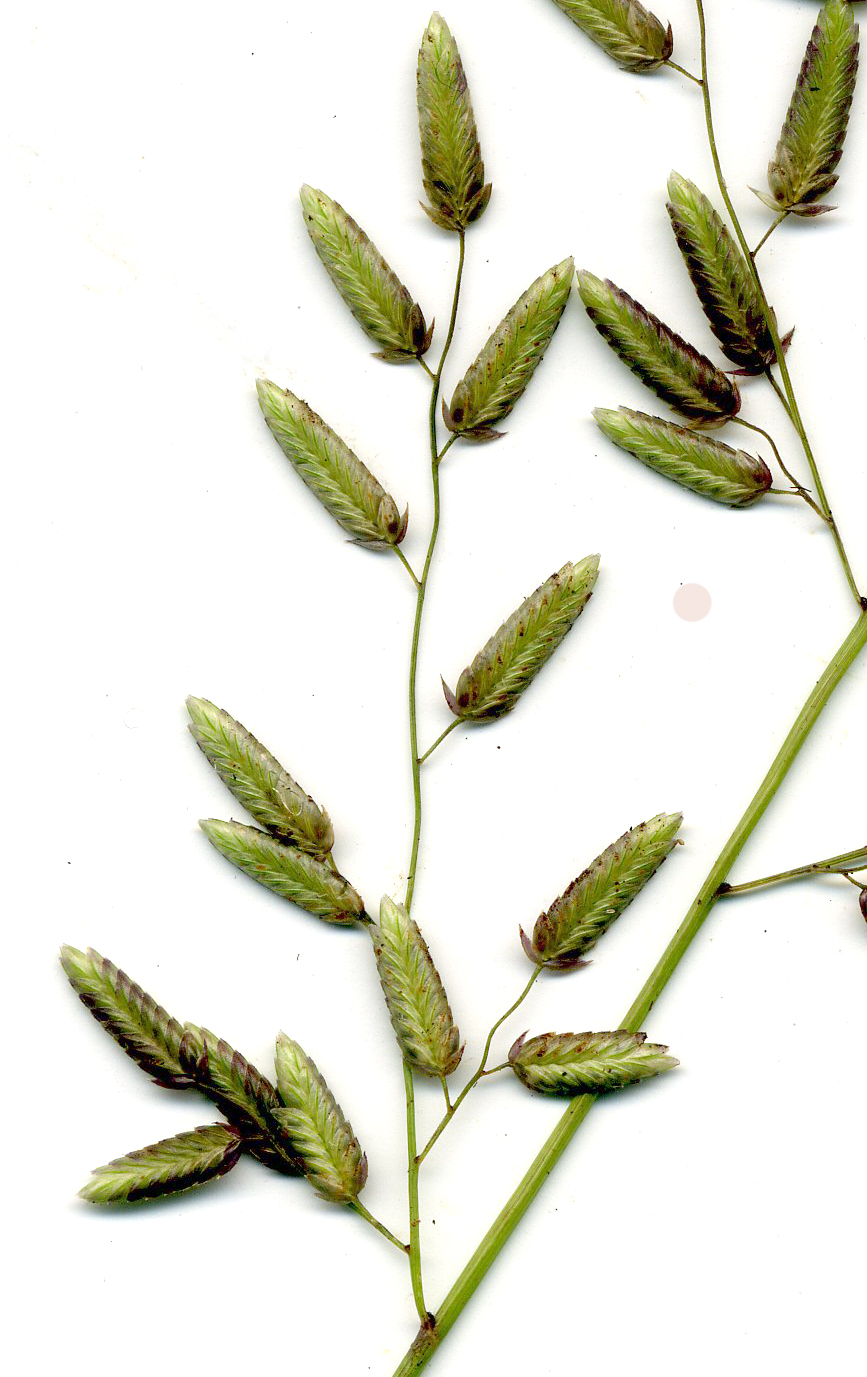
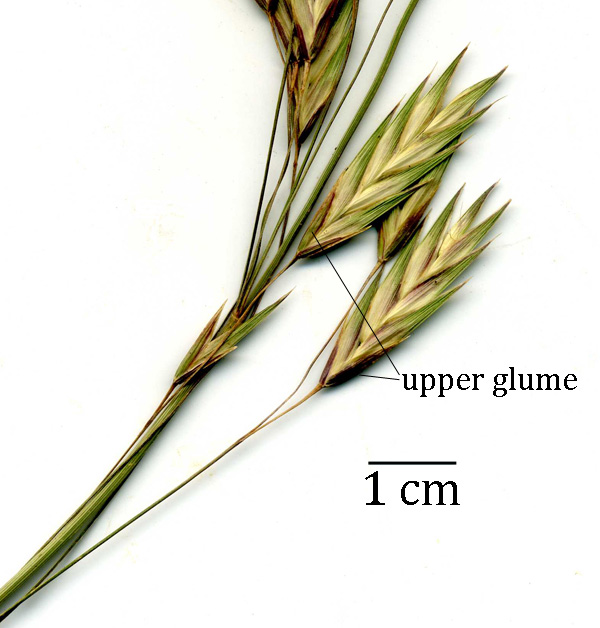
|
|
~~~~ ~~~~~~~~~~~~~~~~~~~~~~~~~
|
|
|
94a
|
(85) |
 Panicle very open at maturity, ovoid in overall shape (see Fig. 14B), the lowest branches up to 40 cm long and typically whorled. Spikelets with or without covering of fine hairs. First or lower glume hyaline at margins, 1/4 to 1/3 length of spikelet, tip obtuse (rounded). Second glume as long as spikelet, 5-nerved. Fertile floret transversely rugose (ridged cross-wise; remove second glume to view)
Panicle very open at maturity, ovoid in overall shape (see Fig. 14B), the lowest branches up to 40 cm long and typically whorled. Spikelets with or without covering of fine hairs. First or lower glume hyaline at margins, 1/4 to 1/3 length of spikelet, tip obtuse (rounded). Second glume as long as spikelet, 5-nerved. Fertile floret transversely rugose (ridged cross-wise; remove second glume to view)
|
|
[95] |
|
94b
|
|
Panicle branches held more vertical, lowest branches not whorled, overall shape not obvious. Spikelets glabrous, elongated and acute at tip. Lower glume ~1/5 to 1/3 length of spikelet, obtuse, even truncate, hyaline. Second glume as long as floret, 7-9-nerved. Surface of fertile floret white, network-like (look under the glumes). { Perennial, with rhizomes; in moist, disturbed environments. HDA noxious weed. Wainaku grass, torpedo grass, quack grass [HAW - NAT] [FAC]
|
|
|
|
~~~~ ~~~~~~~~~~~~~~~~~~~~~~~~~
|
|
|
95a
|
(94) |
 Spikelets without hairs (glabrous). Plants typically 4 to 9 ft (70 - 300 cm) tall, very robust; however, a less robust form, often growing directly adjacent to the larger form occurs (Fig. 14G). Leaf blades on mature plants up to 1 in (3 cm) across, much less on the smaller form. { An extremely common, clumping grass in lowland disturbed areas and pastures, especially mesic and wet areas. Stems have stiff hairs that can cause itching as hairs detach and irritate the skin. A highly variable species with respect to size. Guinea grass [HAW - NAT] [GUM - NAT] [FAC]
Spikelets without hairs (glabrous). Plants typically 4 to 9 ft (70 - 300 cm) tall, very robust; however, a less robust form, often growing directly adjacent to the larger form occurs (Fig. 14G). Leaf blades on mature plants up to 1 in (3 cm) across, much less on the smaller form. { An extremely common, clumping grass in lowland disturbed areas and pastures, especially mesic and wet areas. Stems have stiff hairs that can cause itching as hairs detach and irritate the skin. A highly variable species with respect to size. Guinea grass [HAW - NAT] [GUM - NAT] [FAC] Megathyrsus maximus (Jacq.) B.K. Simon & W.L. Jacobs
|
|
|
95b
|
|
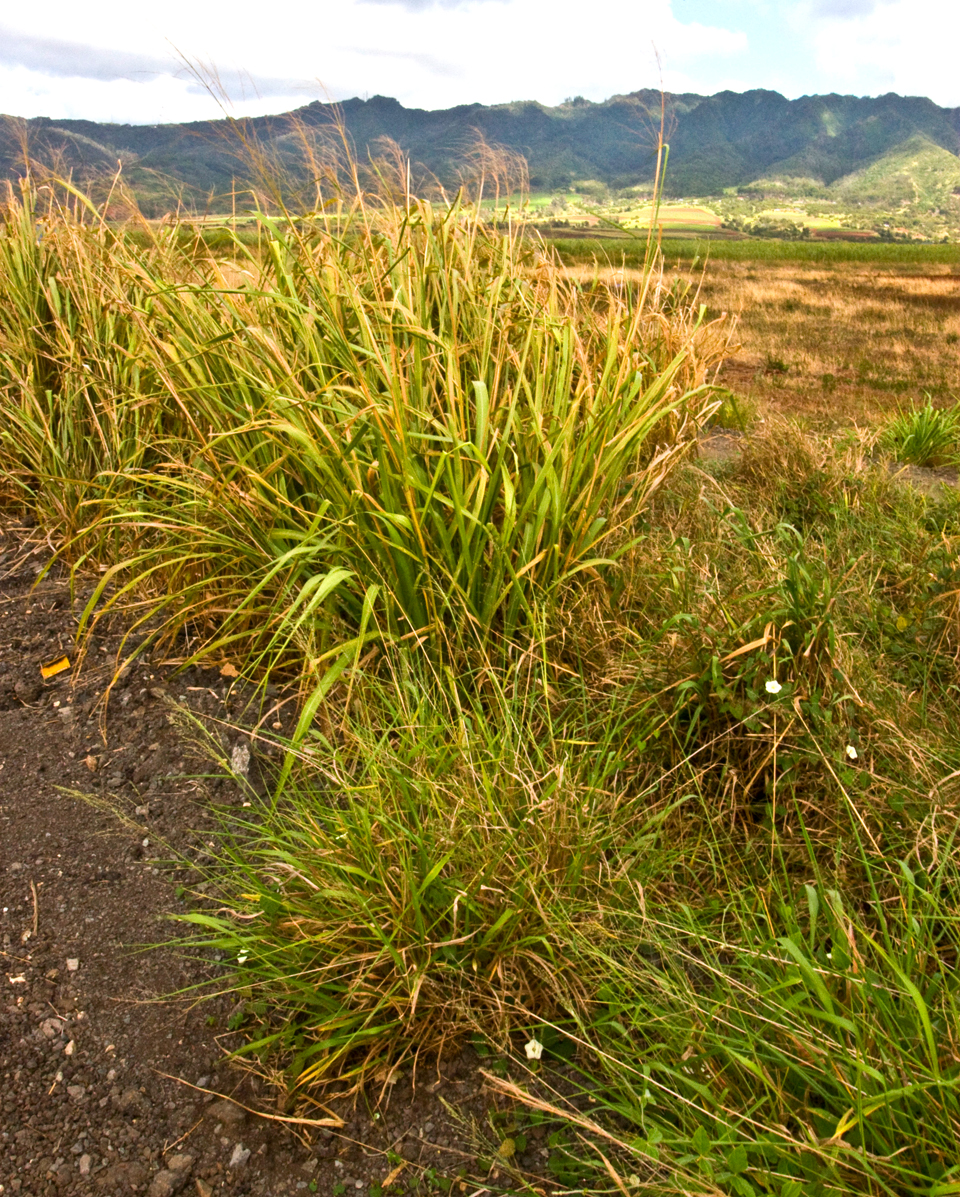
Figure 14H. Habits of two forms of M. maximus. Spikelets identical under magnification.
Spikelets sparsely covered with short hairs. Plants ~3 ft or less in height (including inflorescence); leaf blades on mature plants less than 1/2 in (1.5 cm) across. { Clumping but not especially robust. Common in lowland disturbed areas and pastures, especially in dry areas. Widely considered a synonym of M. maximus, as size and presence or absence of hairs on the glumes are not correlated (Fig. 14G). Guinea grass (short type), green panic [HAW - NAT] [FAC]
Megathyrsus maximus var trichoglume (K. Schum.) C. E. Hibberd
|
|
|
~~~~ ~~~~~~~~~~~~~~~~~~~~~~~~~
|
|
|
96a
|
(88) |
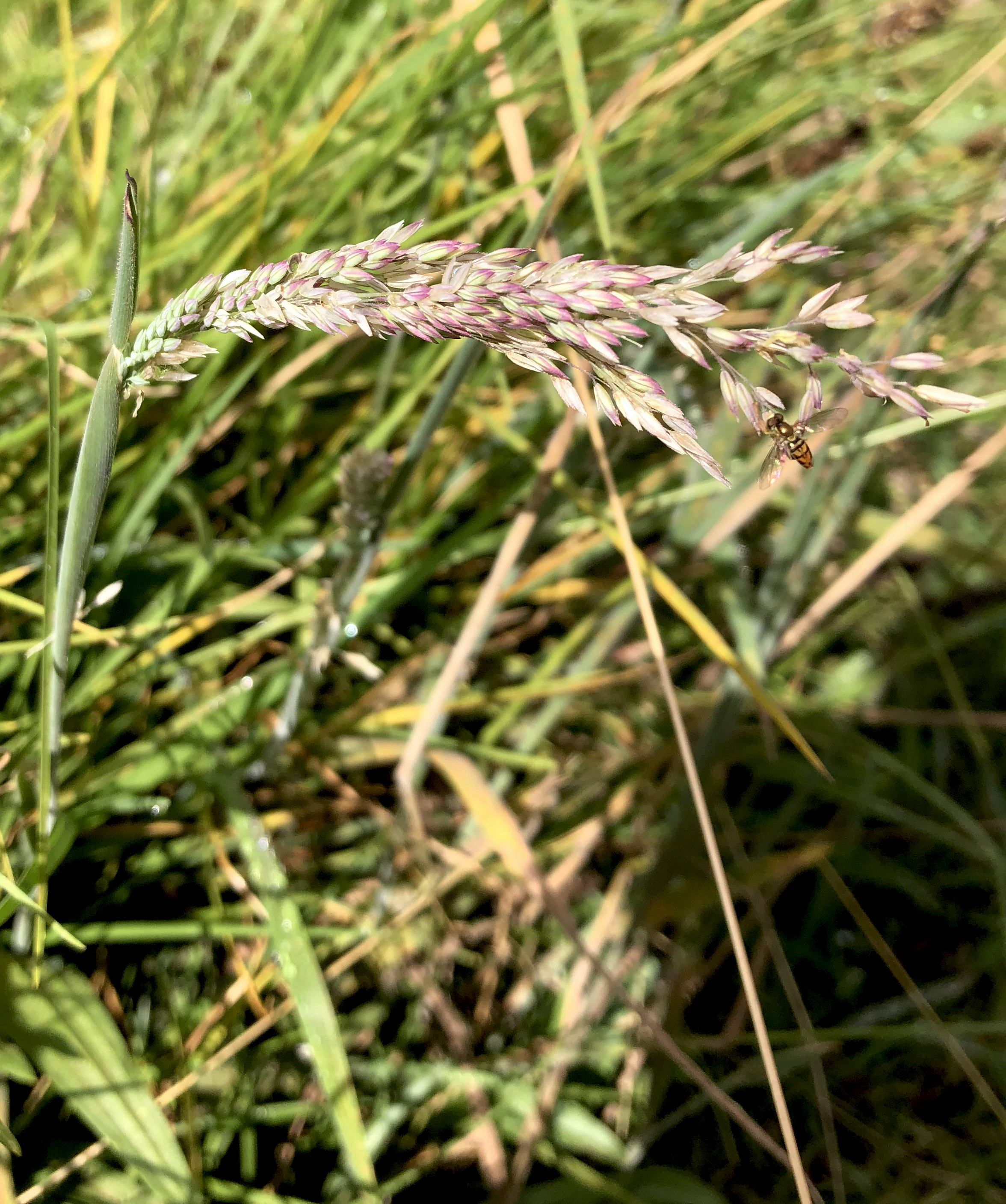 Culm and leaves velvety with fine hairs. Inflorescence much branched, but branches held close to the rachis, then usually spreading at maturity. Glumes keeled, subequal, enclosing florets and short-awned; second glume broad, shaped like a dingy (small boat) with 3 veins; veins either hairy or scabrous. Floret with a small, weakly scabrous, curved awn that just projects above spikelet. Ligule a membrane with scattered hairs. { Common roadside and pasture weed above 2500 ft (760 m). Common velvet grass, Yorkshire fog [HAW - NAT]
Culm and leaves velvety with fine hairs. Inflorescence much branched, but branches held close to the rachis, then usually spreading at maturity. Glumes keeled, subequal, enclosing florets and short-awned; second glume broad, shaped like a dingy (small boat) with 3 veins; veins either hairy or scabrous. Floret with a small, weakly scabrous, curved awn that just projects above spikelet. Ligule a membrane with scattered hairs. { Common roadside and pasture weed above 2500 ft (760 m). Common velvet grass, Yorkshire fog [HAW - NAT]
Figure 14I. Inflorescenses of H. lanatus (photographed by S. Burr; see Fig. 14J to enlarge).
|
|
96b
|
|
Grass not as above .. .
|
|
[110] |
|
~~~~ ~~~~~~~~~~~~~~~~~~~~~~~~~
|
|
|
97a
|
(92) |
Spikelets held erect, less than 0.5 cm (1/4 in) wide. { Common in pastures and along roadsides above 1,000 ft. Little quaking grass [HAW - NAT]
|
|
|
|
97b
|
|
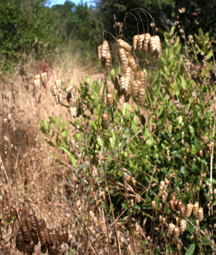 Spikelets drooping, about 1 cm (1/2 in) in width. { Sparingly naturalized above 2,000 ft. Big quaking grass [HAW - NAT]
Spikelets drooping, about 1 cm (1/2 in) in width. { Sparingly naturalized above 2,000 ft. Big quaking grass [HAW - NAT]
Figure 14J. Inflorescenses of B. maxima (photographed in California).
|
|
|
|
~~~~ ~~~~~~~~~~~~~~~~~~~~~~~~~
|
|
|
98a
|
(91) |
Perennial, growing up to 2+ feet in height. Spikelets 2-4 flowered, purplish. { Medium perennial forming dense sod above 4000 ft (1200 m). Kentucky bluegrass [HAW - NAT]
|
|
|
98b
|
|
Annual, tufted, growing up to 8 inches overall in height. Spikelets 3-6 flowered, purplish. { Small annual in typically dry to mesic sites, forming weak mats at best, growing over a wide elevation range. Annual bluegrass [HAW - NAT]
|
|